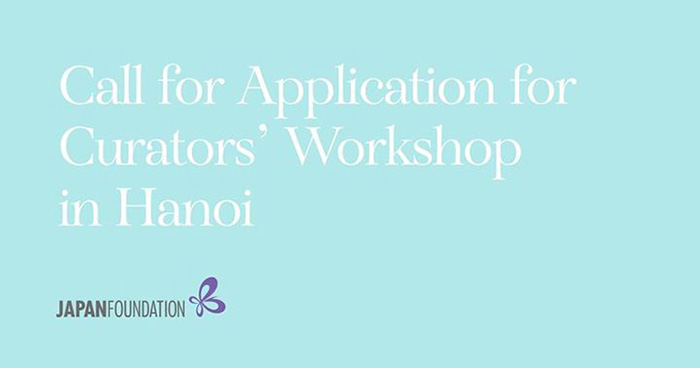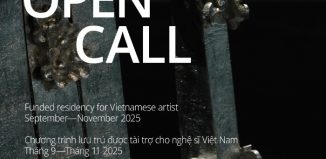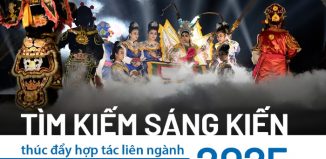Attention Curators: Curators’ Workshop by Japan Foundation – Call for Applications

Call for Applications for Curators’ Workshop by Japan Foundation
Deadline: 27 Nov 2015
From Japan Foundation Center for Cultural Exchange in Vietnam:
The Japan Foundation announces a call for applications to a Curators’ Workshop from November to December in Indonesia, Malaysia, Philippines, Thailand and Vietnam in 2015. It is a program aimed to enhance expertise in curating contemporary art and related platforms. Participants are required to present an exhibition/art project proposal at the workshop and two selected participants will receive a grant for a two weeks study tour in Japan (February 22-March 6. 2016), after which they will be asked to organize an exhibition/art project in early 2017 in Vietnam.
The general theme of the workshop is “What is Southeast Asia?”. Southeast Asia is, on the whole, understood historically as a region that is located between China and India where a diverse range of culture and ethnic groups exist. It has been a strategic location where vessels from the East and the West cross. Many in the region once experienced colonization by the West in the 19th century and becoming an independent nation-state after the Second World War. Today, the region collectively draws attention from elsewhere as ASEAN (Association of Southeast Asian Nations), an association which encourages collaboration among its members in the political, economic, social, and cultural fields. Under this scheme, the members in the region have increasingly shaped each other’s society and culture as broadly conceived.
But for those who reside in the region, what does this regional binding of “Southeast Asia” mean? In the field of the visual arts, for example, national art histories have been written, but is it possible to write a regional art history for the whole of Southeast Asia? How can curators contribute to the regional art scene, while also taking part in the global art scene, both made possible as a result of the advancement in information technology?
For this workshop, with the assistance of the facilitators from the participating countries, the general theme of “What is Southeast Asia?” is broken down into sub-themes that are tailored to meet the local conditions. The applicants of the workshop are requested to submit a project plan that anticipates diverse approaches to the suggested theme along with their applications. We look forward to submission of challenging proposals.
DATES OF WORKSHOP: December 8-9, 2015 (2 days)
VENUE: The Japan Foundation, Center for Cultural Exchange in Vietnam (27 Quang Trung, Hoan Kiem, Hanoi)
LECTURERS
– Mr. Tran Luong – Artist, Curator
– Ms. Sumi Hayashi – Independent Curator, Guest Curator, The National Museum of Art, Osaka
NUMBER OF PARTICIPANTS TO BE ACCEPTED
Maximum of 10 persons
Domestic transportation and accommodation for participants from outside Hanoi will be covered by the Japan Foundation.
ELIGIBILITY
Applying candidates must fulfill the following eligibility:
(1) Those who have broad interests in curatorial practices not limited to contemporary art but also include art history, architecture, material culture, music and performance, etc…
(2) Those who are 35 years old or below at the time of application
(3) Those who are able to attend the full duration of both the workshop (December 8-9) and the study tour in Japan (February 22-March 6, 2016)
(4) Those who commit to participate all the events described in the attached beyond the workshop and the study tour above (ie. Large Exhibition and Local Exhibition, the details are to be announced)
(5) Those who are able to communicate and discuss in English
APPLICATION
Please submit the application form in full with the required documents to Center for Cultural Exchange in Vietnam of the Japan Foundation via e-mail ([email protected] and [email protected]) by 27th November, 2015.
– Application form
– CV
– Portfolio of past 3 projects, if any
– Project Plan in English (max of 800 words essay, with suggested venue/site for exhibition, artist with existing or commissioned artwork, and sketches, photos, installation plan and budget plan – as detailed as possible and if applicable) to be presented/disseminated according to this program concept, which is mentioned below under the theme – “Challenges and differences between reading and presenting artworks in local vs. global contexts”.
Challenges and differences between reading and presenting artworks in local vs. global contexts
In the landscape of a world shifting to a multi-polar one post the cold war, opportunities are opening up for isolated regions and communities to reach the world community with their voices and share their needs, aspirations, humanity viewpoints and beliefs against the backdrop of their local contexts.
Arts and culture is always the envoy to promote mutual understanding and a potential suggestion, a “spokesman” for developments of human civilization.
South East Asia region, including Vietnam, is a place of high concentration of ethnic communities with nomadic practices and a variety of beliefs. Differences in comprehending and presenting artworks represent a challenge not only between local vs. global contexts but also big gaps across major regional metropolitan/cultural hubs vs. the vast majority of the rest, most of whom are still in isolated state culturally.
Curators hold some of the most important roles of “derivatives” in the overall development of contemporary arts and more broadly cultural development.
Call the moment viewers encounter an artwork a central point. The job of a curator will have started before and will continue even after this central point.
So what do the issues and workload of a curator involve – in and out of order?
– How much is the dynamics and understanding between a curator and artists?
– How will a curator share and leverage his/her own social, people, religious and local knowledge in presenting artwork to the public?
– How can censorship create pressure and impacts (both negative and positive) on the process of creation and presentation? What role does curation play in facilitating adjustments so that an artwork/exhibition can be displayed in a public space and can achieve its highest aesthetic and content quality?
– How does a curator invest his time and effort in studying the dynamics between an artwork with a specific display site?
– How do artworks relate to one another to create a flow of concepts and aesthetics in an exhibition?
– What are the impacts of an artwork on different groups of viewers/communities? And, vice versa, how do local viewers/communities’ interactions influence a particular artwork?
– What is an artwork’s projected “life time”?
– Does an exhibition engage dialogues and encourage imagination? Does it provoke thoughts?
– Should sequential versions be developed as an ecosystem of interdependent, mutually supportive exhibitions? Or should each and every exhibition be a unique separate case?
– In today’s contexts, how is impermanence increasing present in all social aspects and changing artistic structures? What lessons and new methods for organization and facilitation can be learnt from this?
※Notes:
1) Interested applicant may propose venues such as an institution, museum, gallery or art space etc…, but it will not be a commercial show. Once selected for production, the curator has to take initiative in securing the space and managing the project.
2) For the workshop, the proposal needs to be developed in the level that curator has artists and actual works for the show in mind (except commissioning of new work), as well as the installation plan.
NOTICE OF AWARD
Those who are accepted to participate in the workshop will be notified by December 1st, 2015.
CONTACT AND INQUIRIES
The Japan Foundation, Center for Cultural Exchange in Vietnam
27 Quang Trung, Hoan Kiem, Hanoi TEL: 04-3944-7419 FAX: 04-3944-7418
Attn: Huynh Thi Thu Huong (Ms.) e-mail: [email protected]
and Pham Le Da Huong (Ms.) e-mail: [email protected]













